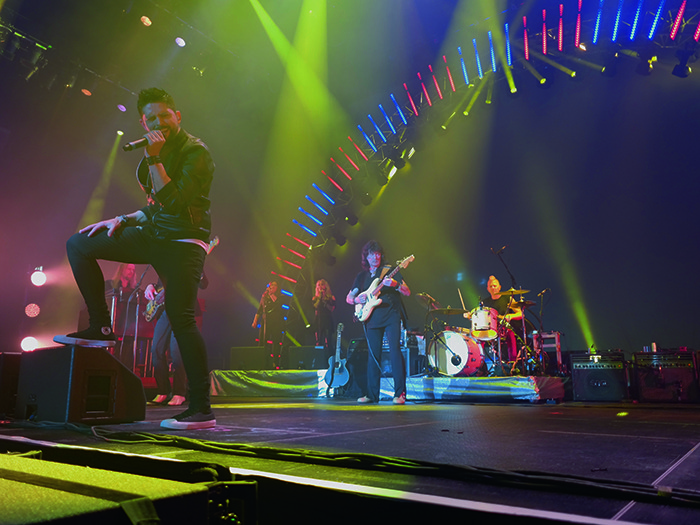TPi’s Ste Durham made the trip to Birmingham to experience a truly monumental performance, as guitar royalty Ritchie Blackmore played his first arena rock show in 20 years with a FOH sound made possible with the help of Soundcraft’s Vi Series.
After spending the best part of two decades away from the world of rock, playing everything from castles to Renaissance fairs with medieval folk seven-piece Blackmore’s Night, it isn’t surprising that revered axe man Ritchie Blackmore was reluctant to commit to a full European tour for his highly-anticipated return. Under the moniker of Ritchie Blackmore’s Rainbow, the artist pencilled in just three dates: two outings at Germany’s Monsters of Rock in Loreley and Bietigheim-Bissingen, respectively, and a solitary date at Birmingham’s Genting Arena, playing a range of songs from both the Rainbow and Deep Purple back catalogues.
The theme of the production design was simple, effective and nostalgic, paying homage to Rainbow tours gone by, while at the same time embracing the benefits of 21st Century technology. Audio, lighting and backline were all geared towards letting the music and musicians do their thing and, somewhat surprisingly in this day and age, video was nowhere to be seen – even the IMAG that is now almost compulsory at arena-sized shows was notably absent in Birmingham.
In place of the upstage video wall or cloth backdrop that I expected to see was a giant rainbow-shaped truss covered in Laser Imagineering SUNBEAM FC LED battens and Clay Paky Sharpys. Lighting Tech for both Blackmore’s Night and Rainbow, Andreas Bock, explained the logic behind the visual set up: “If you want to use back projection or video then you need to create a lot of special content, otherwise it gets boring.”
He continued: “This would mean a lot of work for just three shows. The decision was to do these to get a feeling of how it would be received by the fans. We don’t know if Ritchie wants to do more rock in the future, but if there is a possibility then I’m sure we will add video content. He uses back projection with Blackmore’s Night and really likes it.”
The whole production fits into four trailers, provided by Concert & Event Service and Trucking Service, with three for the main lighting and audio rigs, and one for the rainbow and backline. The rainbow itself is made up of four sections of semi-circular truss that is connected and flown using two hoists. The full arch contains 64 of the Laser Imagineering LED battens and 32 Sharpys.
“I created the rainbow together with our Lighting Designer Michael Bockmühl,” Bock explained. “It’s inspired by the old rainbow but has been designed using modern fixtures. We don’t want to make too much noise with the light and have it look cheap – it’s all about trying to capture that classic rock atmosphere.”
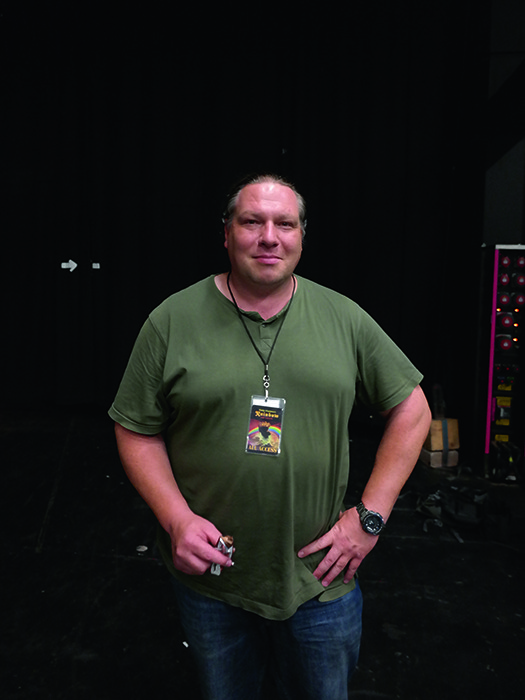
The rainbow itself is a full video show, controlled independently, channel-by-channel on an MA Lighting grandMA2. Although the 64 fixtures create far too big of a pixel pitch to achieve detailed video effects, considerable colour morphing and the appearance of movement could be achieved. One moment in the set, Catch The Rainbow, saw the rainbow grow from one side to the other during the course of the song, while other upbeat tracks such as show opener, Highway Star, necessitated a more action-packed display.
Bockmühl continued: “When we looked back at old shows it became obvious that we would use the rainbow. The old version was this massive thing made of wood, plastic and steel, today it’s truss and LED sticks. There was talk of having video inside the rainbow frame but it comes down to practicality and cost. In the first venue of the tour we would have struggled to hang anything more, so then you are talking about introducing video for only two shows.”
German-based supplier Lleyendecker provided the gear for the rainbow, while satis&fy took care of the main lighting rig. Bockmühl said: “The rest of the rig was dictated by the rainbow. We wanted to accentuate it and carry on that classic rock look they used to have with with a lot of PARcans while still making use of modern moving lights to create big, colourful wash and beam looks.”
The MA network at Genting Arena connected Bockmühl’s own MA Lighting grandMA1 with the grandMA2, which he steered remotely to make use of the console’s effects library. He continued: “I always have to have a bump page ready just in case Ritchie changes the set, but I’ve done Blackmore’s Night for 13 years now so I have a pretty good understanding with him.”
The huge arena rig from satis&fy consisted of 48 PAR64 6Bars, four PAR64 ACL 4Bars, 18 Robe Robin LED Wash 600’s, 20 Robe ColorWash 2500E ATs, 16 Robe BMFLs, 32 Robe Pointes, and 31 8-lite molefays, as well as Robert Juliat Aramis followspots and Avolites ART 2000 switchpacks and dimmer systems.
Bock concluded: “I’m really happy with how the show looks and it seems to have gone down well with the fans. The only problem is that you put so much work in and after three shows it’s gone! Hopefully we will have an opportunity to use it again some day in the future.”
Child In Time
Although Captured Live provided some backline for the short tour, all of Blackmore’s gear was his own, made up of guitars and amplifiers acquired and heavily modified over decades on the road. This formidable arsenal included heads and cabinets from Engl, Fender and Trace Elliot, and only a couple of his famous Fender Stratocasters. Backline Tech and long-time friend of Blackmore’s, Jim Manngård, explained: “The Blackmore’s Night stuff is very complicated instrumentally, using around 15 guitars, all in different tunings, and other instruments such a hurdy gurdy and a mandola. These gigs have been a walk in the park by comparison!”
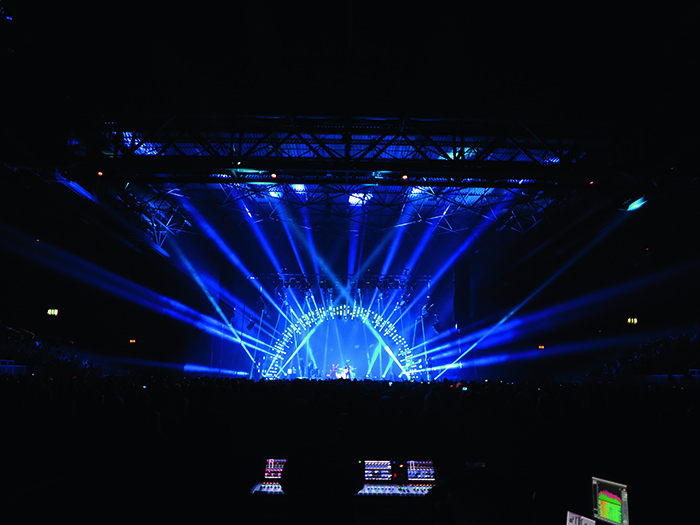
Keyboard Tech Paavo Kurkela was charged with making sure synth virtuoso Jens Johansson’s substantial rig stayed under control – a job made particularly interesting by the use of vintage gear. The kit included a Hammond B-3 and a Leslie 122 in order to pay respect to the iconic Jon Lord tone. Although Kurkela and Johansson created the sound in a different way to Lord, the tech maintained that the B-3 sounded, “the way a B-3 should.”
He commented: “Jens and I took our time in trying to find a sweet spot in terms of the distortion sound. When you put the pedal to the metal there’s a nice crunch out of the B-3 but there’s nothing odd about the way we did it – it was very straightforward. We used two Shure SM57’s on top and an Electro-Voice RE20 on the bottom, which is a standard old school set up. The B-3 was rented from Captured Live in good shape, so all I had to do was wake up a few of the keys.”
Johansson’s other rig was more computer-based, with Windows software controlled by a Roland A-800 Pro. Kurkela continued: “This allows him all sorts of voices, from subtle sounds to the classic Jens Johansson solo tone, which we got using a Roland JV-1080 rack driven through a Morely distortion box. It’s not much different to how the guys did it in the ‘70s when you think about it: they had sound modules too, now they just run on Windows.”
Long Live Rock & Roll
As the three venues on this run varied greatly in terms of their size, coverage requirements and weight hanging restrictions, FOH Engineer Barry Broström was prompted to specify a versatile PA system from Germany’s satis&fy. The main hang at the Genting Arena consisted of 12 boxes of L-Acoustics K1 per side, with three KARA as underhang, 10 K2 for outfill and six more KARA for infill. The bass frequencies were provided by 32 L-Acoustics SB28’s.
Broström commented: “It quickly became apparent during the first two sets of rehearsals in the US that the majority of the mix was already taken care of by the band. They had the song arrangements and their personal backline sound down already, so a minimalist approach was needed from my end. Careful consideration was given to all aspects of the live sound production so that the equipment and mix didn’t get in the way of bringing the music to the audience in the way that Ritchie wanted. This made the selection of gear especially critical.”
To control the 32 channels he had at FOH, as well as the additional 10 channels of audience microphones and spares, Broström specified a Soundcraft Vi7000.
“With the Soundcraft Vi series I was especially able to focus on what was important, which was delivering an experience to the fans which brought them closer to the music they haven’t heard live in two decades,” said Broström.
He continued: “I could not have been happier with my choice of the Vi7000 for these shows. I am really pleased with the Soundcraft team for making these products available to those of us who still care about mixing live shows as an art form rather than a random exercise in tech geekery! There was never a time during rehearsals or the shows where I felt lost in the technology and, as you know, that is rare these days. As well as being a total pleasure to use, the desk sounds fantastic.”
There was a period during the initial planning stage where Broström considered going back to analogue for these shows, but once he considered the impracticalities of that idea, the Vi series quickly became a “no-brainer”.
He said: “To be honest the Vi series completely surpasses the analogue domain in every conceivable way; the ease of operation, the features, and above all the sound quality made the Vi series the perfect choice for these shows. I seem to fall somewhere into the age group where I am young enough to be ‘hip’ to digital, while being old enough to have been brought up in the analogue world. These consoles are the perfect marriage of the two.”
According to Broström, one of the desk’s main strengths is the Vistonics screens corresponding to each group of eight faders; a feature that both speeds up and simplifies on-the-spot adjustments. He explained: “Having the knobs right there on the screen means being able to access whatever you need without ever taking your attention off of the show, just like an analogue desk – but even better. This was also my first time using the Realtime Rack, and although I didn’t have the chance on just three shows to even scratch the surface of this, the ease of use and the capabilities were just stunning. The Vi series plus the Realtime Rack is certainly a winning combination.”
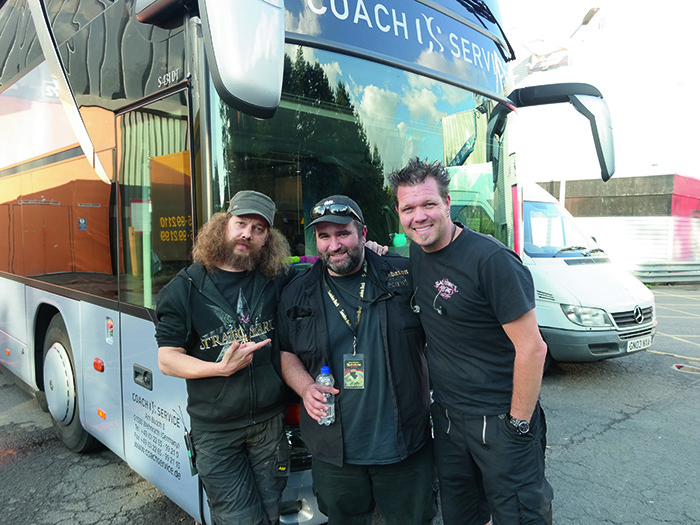
Broström asserted that the desk was integral to achieving the simplicity required for this gig. He mainly used one mix, adding ‘80s-style drum reverbs on the Perfect Strangers era songs, or vintage spooky sounding plate and spring vocal reverbs on the ‘70s Dio era songs where required, which allowed the musicians themselves to handle the mix with their instruments and dynamics.
The band used a combination of Shure PSM 1000 in-ears and L-Acoustics 115XT HiQ wedges for on-stage monitoring to back up KARA side fills. Monitor Engineer Lars Nawrot has been on the road with Blackmore for the past six years, and in that time has come to understand his expectations to the letter. For the three Rainbow dates, this meant keeping his eyes on the artist at all times in order to shift the mix on his Yamaha CL5 accordingly.
Nawrot explained: “Ritchie does not use a traditional monitor mix, so he has no floor wedges or IEMs, instead he relies on a combination of the side fill, drum fill, backline and the FOH mix coming off the back of the PA and reflecting off of the room. If Ritchie wants to hear a particular band member, he walks towards the instrument, so I have to stay switched on at all times. I think coming from the old school influences his monitor tastes in this way – he’s used to working like that. It took me a while to understand his stage mix but now it has become second nature.”
Although Nawrot’s RF workload on the night was relatively manageable with only four wireless and six in-ear channels to look after, the crew was initially concerned with how the LED rainbow would affect the kit on stage.
Broström said: “I have been told that the old rainbow sometimes used to make Richie’s guitar go crazy, and was even a showstopper on a few occasions. He was concerned this might happen again so we flew his guitar rig over to Germany, set up the rainbow and moved the rig and guitar around underneath it. Luckily the signal was clean wherever we moved the gear, so we reported back to Ritchie and were good to go.”
As well as making sure that Blackmore’s iconic riffs could be heard loud and clear in the arena, the audio team had to find the perfect microphone to match new lead singer Ronnie Romero’s colossal voice. “We tried a variety of capsules from Shure that satis&fy supplied, but none of them quite worked as they should with Ronnie,” remembered Broström. “We eventually realised that the wired KSM8’s being used by the backing vocalists were the best microphones on stage. As soon as we got a wireless KSM8 capsule for him we knew there was no going back.”
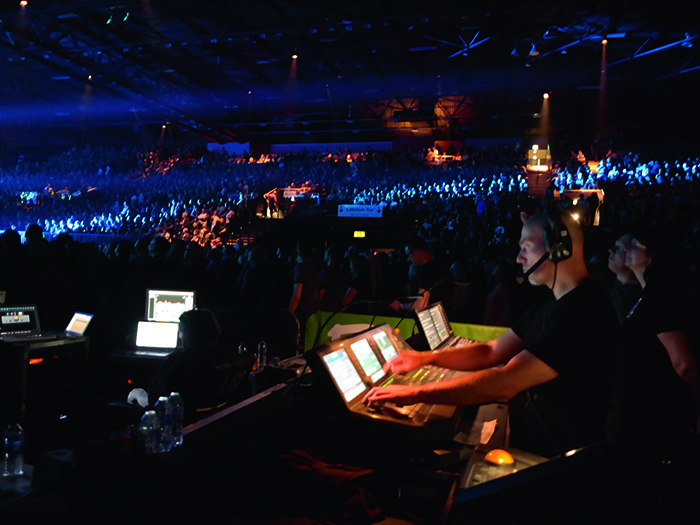
The sound in the arena was thunderous, and Romero’s vocals sounded as crisp and intelligible as promised. It must be said that, in the months preceding the shows, some of the Deep Purple / Rainbow faithful were initially sceptical of a new singer filling the shoes of such legendary frontmen as David Coverdale, Ian Gillan and Ronnie James Dio, but the young Chilean was a force of nature on the night in Birmingham.
For the rest of the band, Broström’s priority was to try and capture a vintage sound to compliment the songs themselves as well as the overall aesthetic.
He explained: “I put both overheads on a single stand for the drums, as it’s easier to delay the rest of the drum channels to the overheads if they are coming from a single point. I aim for a really natural drum sound, which means using as little gating as possible to let them breathe. Ritchie wanted the focus to be on the music; not a huge wall of backline and a massive drum kit. This was the general theme around the production – keep it simple and let the band do their thing.
“I was not interested in doing the over the top loud drum mix common in many of today’s live concerts, but rather honour the balances found on the original recordings, while finding a middle ground and taking advantage of the power and sonics of a modern PA system.”
As well as Shure and Electro-Voice gear that was used on stage, Broström and the crew selected a range of Sennheiser, Neumann, Audix, and AKG microphones.
Assisting Broström with the audio rig were satis&fy Systems Techs Johan Schreuder and Rüdiger Nürnberg. Broström said: “Johan and Rüdiger really took great care to make sure that the system sounded great and the coverage was even throughout the venue, as well of taking care of me too!”
Since You’ve Been Gone
Whether Blackmore decides to continue blowing the dust off his electric guitars remains to be seen, but there was certainly a few thousand in the Genting Arena that night who will be praying to the gods of rock that he does. At the same time as satisfying those in the arena, the tour has also been a hit with the crew backstage. So would they return to the road together with Ritchie Blackmore’s Rainbow, given the chance?
When I asked him, Broström smiled: “Despite this being a very short tour, the vibe came together instantly. It’s a lot of the core team from Blackmore’s Night but we all clicked from first night of rehearsals. It’s been great and the only shame is that we couldn’t put this show on for longer. In the future… you never know!”
TPi
www.satis-fy.com
www.lleyendecker.com
www.coachservice.com
www.concert-service.com
www.truckingservice.de
www.captured-live.com

